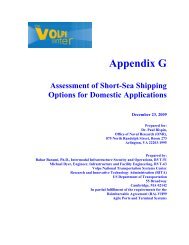ERRV Viking Islay - Marine Accident Investigation Branch
ERRV Viking Islay - Marine Accident Investigation Branch
ERRV Viking Islay - Marine Accident Investigation Branch
- No tags were found...
Create successful ePaper yourself
Turn your PDF publications into a flip-book with our unique Google optimized e-Paper software.
users with a warning should the oxygen level within an enclosed space reduce to ahazardous level. The Crowcon EIKON held on board <strong>Viking</strong> <strong>Islay</strong> had a limited shelf lifeand had become time expired. Accordingly, in February 2007, ship's staff had ordereda replacement as described below:EKON H 2 S gas monitor: make Crowcon [sic].As a consequence, Vroon supplied the ship with a disposable single gas monitor for theprotection of personnel against toxic H 2 S hazard 10 as a replacement.The crew of <strong>Viking</strong> <strong>Islay</strong> were unaware that the original O 2 “meter” was in fact apersonal gas alarm and not an atmosphere testing device, and that the replacementpersonal gas alarm supplied by Vroon detected H 2 S and not O levels.21.11.2Other equipment<strong>Viking</strong> <strong>Islay</strong> had no portable vent fans or portable lighting at the time of the accident.<strong>Viking</strong> <strong>Islay</strong> was provided with a dedicated air compressor in order to re-fill BA cylinderson board. This allowed more realistic drills to be undertaken, as the crew were able tobecome practised in the use of BA, yet retain the ship’s emergency response capabilityat all times.1.12 Emergency Escape Breathing Devices1.12.1 Requirement to provide Emergency Escape Breathing Devices<strong>Viking</strong> <strong>Islay</strong> carried five Sabre Emergency Life Support Apparatus (ELSA), inaccordance with statutory requirements 11 to carry EEBDs. These devices providepersonnel with breathing protection against a hazardous atmosphere, while escapingto a place of safety. IMO MSC Circular 849 specifically forbids the use of EEBDs forentering oxygen deficient voids or tanks. 121.12.2 EEBDs provided on board <strong>Viking</strong> <strong>Islay</strong> – Sabre ELSA typeThe Sabre ELSA is a self-contained, open circuit, compressed air, constant flow EEBD.It comprises a compressed air cylinder with a combined reducer/cylinder valve, attachedto a close fitting escape hood by a breathing hose. The whole unit is contained withina stowage bag ready for immediate use. The high-visibility bag is clearly markedESCAPE USE ONLY (Figures 10 and 11).10 Hydrogen Sulphide [H 2 S], an extremely hazardous, toxic gas. It is a colourless, flammable gas that canbe identified, in relatively low concentrations, by a characteristic rotten egg odour. The gas occurs naturallyas a product of decaying sulphur-containing organic matter, particularly under low oxygen conditions. Manypetroleum industry jobsites are potential locations of this gas.11 SOLAS 74 Chapter II-2, Part D, Reg 13, paragraph 3.4. Promulgated by IMO MSC/Circ.849 of June1998, this amended regulation required EEBD to be carried on board most vessels. This SOLAS amendmentwas given effect within UK regulations by SI 2003 No.2951, the Merchant Shipping (Fire Protection)Regulations (Amendment) Regulations 2003.12 Paragraph 2 of the Annex to MSC/Circ.849 of June 1998 states: An EEBD is a supplied-air device onlyused for escape from a compartment that has a hazardous atmosphere…EEBD’s are not to be used forfighting fires, entering oxygen deficient voids or tanks, or worn by fire fighters. This is repeated in Annex 1 ofMGN 215 (M+F), dated March 2002.19
















